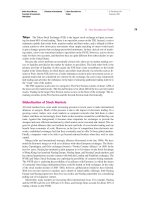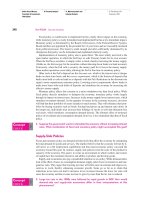Feldman s essentials of understanding psychology 8th ed
Bạn đang xem bản rút gọn của tài liệu. Xem và tải ngay bản đầy đủ của tài liệu tại đây (39.66 MB, 690 trang )
EIGHTH EDITION
Essentials of
Understanding
Psychology
Robert S. Feldman
University of Massachusetts, Amherst
fel70207_fm_i-li.indd i
9/30/08 6:22:15 PM
ESSENTIALS OF UNDERSTANDING PSYCHOLOGY
Published by McGraw-Hill, an imprint of The McGraw-Hill Companies, Inc., 1221 Avenue of the
Americas, New York, NY 10020. Copyright © 2009, 2008, 2005, 2002, 1999, 1996, 1993, 1990, 1987 by
the McGraw-Hill Companies, Inc. All rights reserved. No part of this publication may be reproduced
or distributed in any form or by any means, or stored in a database or retrieval system, without
the prior written consent of The McGraw-Hill Companies, Inc., including, but not limited to, in
any network or other electronic storage or transmission, or broadcast for distance learning. Some
ancillaries, including electronic and print components, may not be available to customers outside
the United States.
This book is printed on acid-free paper.
1 2 3 4 5 6 7 8 9 0 DOW/DOW 0 9 8
ISBN: 978-0-07-337020-0
MHID: 0-07-337020-7
Vice President and
Editor in Chief: Michael Ryan
Editorial Director: Beth Mejia
Publisher: Michael Sugarman
Director of Development: Dawn Groundwater
Development Editor: Barbara Conover
Supplements Editor: Emily Pecora
Editorial Coordinator: Jillian Allison
Executive Marketing Manager: James R.
Headley
Production Editors: Melissa Williams and Scott
Hitchcock, EPS Inc. NYC
Manuscript Editor: Laura Glenn
Cover Designer: Allister Fein
Interior Designer: Ellen Pettengell
Senior Production Supervisor: Rich DeVitto
Photo Researcher: Connie Mueller
Cover Photos: (c) Royalty-Free/Corbis
Psychology Advisory Board:
Melissa Acevedo, Westchester Community
College
Jennifer Brooks, Collin County
Community College
Jeffrey Green, Virginia Commonwealth
University
Holly Haynes, Georgia Perimeter College
Julie Bauer Morrison, Glendale
Community College
Phil Pegg, Western Kentucky University
Tammy Rahhal, University of
Massachusetts, Amherst
Tanya Renner, University of Hawaii
Carla Strassle, York College of
Pennsylvania
Jim Stringham, University of Georgia
This book was set in 9.5/12 Palatino by Electronic Publishing Services, Inc. and printed on 45# Pub
Influence Gloss by R.R. Donnelley and Sons.
Photo and text credits can be found following the References on page C-1, a continuation of
the copyright page.
Library of Congress Cataloging-in-Publication Data
Feldman, Robert S. (Robert Stephen)
Essentials of understanding psychology / Robert S. Feldman. -- 8th ed.
p. cm.
Includes bibliographical references and indexes.
ISBN-13: 978-0-07-337020-0
ISBN-10: 0-07-337020-7
1. Psychology--Textbooks. I. Title.
BF121.F34 2009
150--dc22
2008041141
www.mhhe.com
fel70207_fm_i-li.indd ii
10/7/08 10:23:48 AM
To
Jonathan, Leigh, Alex, Joshua,
Julie, Sarah, and Kathy
fel70207_fm_i-li.indd iii
9/30/08 6:22:16 PM
fel70207_fm_i-li.indd iv
9/30/08 6:22:16 PM
About the Author
ROBERT S. FELDMAN is Professor of Psychology and Associate Dean of the
College of Social and Behavioral Sciences at the University of Massachusetts at
Amherst. Feldman, a winner of the College Distinguished Teacher award, has also
taught courses at Mount Holyoke College, Wesleyan University, and Virginia
Commonwealth University.
Feldman, who initiated the Minority Mentoring Program, teaches introductory
psychology to classes ranging in size from 20 to nearly 500 students. He also has
served as a Hewlett Teaching Fellow and Senior Online Teaching Fellow, and he frequently gives talks on the use of technology in teaching. He initiated distance learning
courses in psychology at the University of Massachusetts.
Feldman also is actively involved in promoting the field of psychology. He is on
the Board of Directors of the Federation of Behavioral, Psychological, and Cognitive
Sciences, and also is on the Board of the Foundation for the Advancement of Behavioral
and Brain Sciences.
A Fellow of the American Psychological Association and the Association for
Psychological Science, Feldman received a B.A. with High Honors from Wesleyan
University and an M.S. and Ph.D. from the University of Wisconsin–Madison. He is
a winner of a Fulbright Senior Research Scholar and Lecturer award, and has written
more than 100 books, book chapters, and scientific articles. His books include
Fundamentals of Nonverbal Behavior, Development of Nonverbal Behavior in Children,
Social Psychology, Development Across the Life Span, and P.O.W.E.R. Learning: Strategies
for Success in College and Life, and they have been translated into a number of languages, including Spanish, French, Portuguese, Dutch, Chinese, and Japanese. His
research interests include honesty and deception and the use of nonverbal behavior
in impression management, and his research has been supported by grants from the
National Institute of Mental Health and the National Institute on Disabilities and
Rehabilitation Research.
Feldman’s spare time is most often devoted to earnest, if not entirely expert, piano
playing, and serious cooking. He also loves to travel. He has three children and lives
with his wife, who is also a psychologist, overlooking the Holyoke mountain range in
Amherst, Massachusetts.
v
fel70207_fm_i-li.indd v
9/30/08 6:22:16 PM
fel70207_fm_i-li.indd vi
9/30/08 6:22:21 PM
Brief Contents
CHAPTER 1
Introduction to Psychology 2
MODULE 1
MODULE 2
MODULE 3
MODULE 4
CHAPTER 2
Neuroscience and Behavior 50
MODULE 5
MODULE 6
MODULE 7
CHAPTER 3
Psychologists at Work 5
A Science Evolves: The Past, the Present,
and the Future 15
Research in Psychology 27
Research Challenges: Exploring the Process 41
Neurons: The Basic Elements of Behavior 53
The Nervous System and the Endocrine System:
Communicating Within the Body 61
The Brain 71
Sensation and Perception 88
MODULE 8
MODULE 9
MODULE 10
MODULE 11
Sensing the World Around Us 91
Vision: Shedding Light on the Eye 95
Hearing and the Other Senses 105
Perceptual Organization: Constructing
Our View of the World 117
vii
fel70207_fm_i-li.indd vii
9/30/08 6:22:21 PM
viii
Brief Contents
CHAPTER 4
States of Conciousness 130
MODULE 12
MODULE 13
MODULE 14
CHAPTER 5
Learning 166
MODULE 15
MODULE 16
MODULE 17
CHAPTER 6
MODULE 19
MODULE 20
MODULE 22
MODULE 23
Thinking and Reasoning 241
Language 257
Intelligence 267
Motivation and Emotion 286
MODULE 24
MODULE 25
MODULE 26
fel70207_fm_i-li.indd viii
The Foundations of Memory 205
Recalling Long-Term Memories 219
Forgetting: When Memory Fails 229
Thinking, Language, and Intelligence 238
MODULE 21
CHAPTER 8
Classical Conditioning 169
Operant Conditioning 177
Cognitive Approaches to Learning 191
Memory 202
MODULE 18
CHAPTER 7
Sleep and Dreams 133
Hypnosis and Meditation 145
Drug Use: The Highs and Lows of
Conciousness 151
Explaining Motivation 289
Human Needs and Motivation: Eat, Drink,
and Be Daring 297
Understanding Emotional Experiences 313
9/30/08 6:22:21 PM
Brief Contents
CHAPTER 9
Development 324
MODULE 27
MODULE 28
MODULE 29
MODULE 30
CHAPTER 10
MODULE 32
MODULE 33
MODULE 35
MODULE 36
Stress and Coping 417
Psychological Aspects of Illness
and Well-Being 429
Promoting Health and Wellness 437
Psychological Disorders 444
MODULE 37
MODULE 38
MODULE 39
fel70207_fm_i-li.indd ix
Psychodynamic Approaches to Personality 383
Trait, Learning, Biological and Evolutionary,
and Humanistic Approaches to Personality 393
Assessing Personality: Determining What Makes
Us Distinctive 405
Health Psychology: Stress, Coping,
and Well-Being 414
MODULE 34
CHAPTER 12
Nature and Nurture, and Prenatal
Development 327
Infancy and Childhood 339
Adolescence: Becoming an Adult 359
Adulthood 369
Personality 380
MODULE 31
CHAPTER 11
ix
Normal Versus Abnormal: Making
the Distinction 447
The Major Psychological Disorders 457
Psychological Disorders in Perspective 477
9/30/08 6:22:21 PM
x
Brief Contents
CHAPTER 13
Treatment of Psychological Disorders 484
MODULE 40
MODULE 41
MODULE 42
CHAPTER 14
Psychotherapy: Psychodynamic, Behavioral,
and Cognitive Approaches to Treatment 487
Psychotherapy: Humanistic, Interpersonal,
and Group Approaches to Treatment 499
Biomedical Therapy: Biological Approaches
to Treatment 507
Social Psychology 518
MODULE 43
MODULE 44
MODULE 45
MODULE 46
Attitudes and Social Cognition 521
Social Influence and Groups 531
Prejudice and Discrimination 539
Positive and Negative Social Behavior 545
Glossary G-1
References R-1
Credits C-1
Name Index I-1
Subject Index I-11
fel70207_fm_i-li.indd x
9/30/08 6:22:21 PM
Contents
Preface xxiii
CHAPTER 1
Introduction to Psychology 2
MODULE 1
Psychologists at Work 5
The Subfields of Psychology: Psychology’s Family Tree 6
Working at Psychology 9
MODULE 2
A Science Evolves: The Past, the Present,
and the Future 15
The Roots of Psychology 15
Today’s Perspectives 18
APPLYING PSYCHOLOGY IN THE 21ST CENTURY: Psychology Matters 21
Psychology's Key Issues and Controversies 22
Psychology's Future 24
MODULE 3
Research in Psychology 27
The Scientific Method 27
Psychological Research 29
Descriptive Research 29
Experimental Research 32
xi
fel70207_fm_i-li.indd xi
9/30/08 6:22:22 PM
xii
Contents
MODULE 4
Research Challenges: Exploring
the Process 41
The Ethics of Research 41
EXPLORING DIVERSITY: Choosing Participants Who Represent the Scope of
Human Behavior 42
Should Animals Be Used in Research? 43
Threats to Experimental Validity: Avoiding Experimental Bias 44
BECOMING AN INFORMED CONSUMER OF PSYCHOLOGY: Thinking Critically About Research 45
MASTERING the difference between dependent and independent variables 48
CHAPTER 2
MODULE 5
Neuroscience and Behavior 50
Neurons: The Basic Elements
of Behavior 53
The Structure of the Neuron 53
How Neurons Fire 54
Where Neurons Meet: Bridging the Gap 56
Neurotransmitters: Multitalented Chemical Couriers 58
MODULE 6
The Nervous System and the Endocrine
System: Communicating Within
the Body 61
The Nervous System: Linking Neurons 61
The Evolutionary Foundations of the Nervous System 63
The Endocrine System: Of Chemicals and Glands 66
MODULE 7
The Brain 71
Studying the Brain’s Structure and Functions: Spying on the Brain 71
APPLYING PSYCHOLOGY IN THE 21ST CENTURY: How Neuroscience Is Helping Patients
with Brain Injuries 73
The Central Core: Our “Old Brain” 74
The Limbic System: Beyond the Central Core 75
The Cerebral Cortex: Our “New Brain” 76
NEUROSCIENCE IN YOUR LIFE: Sentence and Melody Generation 78
Neuroplasticity and the Brain 79
The Specialization of the Hemispheres: Two Brains or One? 80
fel70207_fm_i-li.indd xii
9/30/08 6:22:23 PM
Contents
xiii
EXPLORING DIVERSITY: Human Diversity and the Brain 81
The Split Brain: Exploring the Two Hemispheres 82
BECOMING AN INFORMED CONSUMER OF PSYCHOLOGY: Learning to Control Your Heart—and
Mind—Through Biofeedback 83
MASTERING the action potential 86
CHAPTER 3
MODULE 8
Sensation and Perception 88
Sensing the World Around Us 91
Absolute Thresholds: Detecting What’s Out There 92
Difference Thresholds: Noticing Distinctions Between Stimuli 93
Sensory Adaptation: Turning Down Our Responses 93
MODULE 9
Vision: Shedding Light on the Eye 95
Illuminating the Structure of the Eye 96
Color Vision and Color Blindness: The 7-Million-Color Spectrum 100
APPLYING PSYCHOLOGY IN THE 21ST CENTURY: Vision Revision: Giving Sight Back
to the Blind 103
MODULE 10
Hearing and the Other Senses 105
Sensing Sound 105
Smell and Taste 108
The Skin Senses: Touch, Pressure, Temperature, and Pain 111
BECOMING AN INFORMED CONSUMER OF PSYCHOLOGY: Managing Pain 113
How Our Senses Interact 114
NEUROSCIENCE IN YOUR LIFE: Sensory Processing 115
MODULE 11
Perceptual Organization: Constructing
Our View of the World 117
The Gestalt Laws of Organization 117
Top-Down and Bottom-Up Processing 118
Perceptual Constancy 120
Depth Perception: Translating 2-D to 3-D 121
Motion Perception: As the World Turns 122
Perceptual Illusions: The Deceptions of Perceptions 122
EXPLORING DIVERSITY: Culture and Perception 124
MASTERING the difference between sensation and perception 128
fel70207_fm_i-li.indd xiii
9/30/08 6:22:26 PM
xiv
Contents
CHAPTER 4
States of Consciousness 130
MODULE 12
Sleep and Dreams 133
The Stages of Sleep 134
REM Sleep: The Paradox of Sleep 135
Why Do We Sleep, and How Much Sleep Is Necessary? 136
The Function and Meaning of Dreaming 137
Sleep Disturbances: Slumbering Problems 140
Circadian Rhythms: Life Cycles 140
Daydreams: Dreams Without Sleep 141
BECOMING AN INFORMED CONSUMER OF PSYCHOLOGY: Sleeping Better 142
MODULE 13
Hypnosis and Meditation 145
Hypnosis: A Trance-Forming Experience? 145
Meditation: Regulating Our Own State of Consciousness 147
EXPLORING DIVERSITY: Cross-Cultural Routes to Altered States
of Consciousness 148
NEUROSCIENCE IN YOUR LIFE: Long-Term Effects of Meditation 148
MODULE 14
Drug Use: The Highs and Lows
of Consciousness 151
Stimulants: Drug Highs 153
Depressants: Drug Lows 156
APPLYING PSYCHOLOGY IN THE 21ST CENTURY: Time in a Bottle 159
Narcotics: Relieving Pain and Anxiety 159
BECOMING AN INFORMED CONSUMER OF PSYCHOLOGY: Identifying Drug and Alcohol
Problems 161
CHAPTER 5
Learning 166
MODULE 15
Classical Conditioning 169
The Basics of Classical Conditioning 170
Applying Conditioning Principles to Human Behavior 172
fel70207_fm_i-li.indd xiv
9/30/08 6:22:32 PM
Contents
xv
Extinction 173
Generalization and Discrimination 174
Beyond Traditional Classical Conditioning: Challenging Basic Assumptions 174
MODULE 16
Operant Conditioning 177
Thorndike’s Law of Effect 177
The Basics of Operant Conditioning 178
APPLYING PSYCHOLOGY IN THE 21ST CENTURY: Gaming the Job: Motivating Workers
Through Operant Conditioning 185
BECOMING AN INFORMED CONSUMER OF PSYCHOLOGY: Using Behavior Analysis
and Behavior Modification 188
MODULE 17
Cognitive Approaches to Learning 191
Latent Learning 191
Observational Learning: Learning Through Imitation 193
NEUROSCIENCE IN YOUR LIFE: Behaviors and Brain Activation 194
EXPLORING DIVERSITY: Does Culture Influence How We Learn? 195
MASTERING the distinction between reinforcement and punishment 200
CHAPTER 6
Memory 202
MODULE 18
The Foundations of Memory 205
Sensory Memory 206
Short-Term Memory 207
Long-Term Memory 210
NEUROSCIENCE IN YOUR LIFE: Size of the Hippocampus in Taxi Drivers 215
APPLYING PSYCHOLOGY IN THE 21ST CENTURY: Dulling the Edges of Painful Memory 216
MODULE 19
Recalling Long-Term Memories 219
Retrieval Cues 219
Levels of Processing 220
Explicit and Implicit Memory 221
Flashbulb Memories 222
Constructive Processes in Memory: Rebuilding the Past 223
EXPLORING DIVERSITY: Are There Cross-Cultural Differences in Memory? 226
fel70207_fm_i-li.indd xv
9/30/08 6:22:37 PM
xvi
Contents
MODULE 20
Forgetting: When Memory Fails 229
Why We Forget 230
Proactive and Retroactive Interference: The Before and After of Forgetting 231
Memory Dysfunctions: Afflictions of Forgetting 232
NEUROSCIENCE IN YOUR LIFE: Alzheimer's Disease: Changes in the Brain 233
BECOMING AN INFORMED CONSUMER OF PSYCHOLOGY: Improving Your Memory 234
CHAPTER 7
Thinking, Language, and Intelligence 238
MODULE 21
Thinking and Reasoning 241
Mental Images: Examining the Mind’s Eye 241
Concepts: Categorizing the World 242
Algorithms and Heuristics 243
Solving Problems 244
Creativity and Problem Solving 252
APPLYING PSYCHOLOGY IN THE 21ST CENTURY: Creativity in the Workplace 254
BECOMING AN INFORMED CONSUMER OF PSYCHOLOGY: Thinking Critically
and Creatively 254
MODULE 22
Language 257
Grammar: Language’s Language 257
Language Development: Developing a Way with Words 258
Understanding Language Acquisition: Identifying the Roots of Language 259
The Influence of Language on Thinking: Do Eskimos Have More Words for
Snow Than Texans Do? 261
Do Animals Use Language? 262
EXPLORING DIVERSITY: Teaching with Linguistic Variety: Bilingual Education 263
NEUROSCIENCE IN YOUR LIFE: Brain Functioning in Bilingual Speakers 264
MODULE 23
Intelligence 267
Theories of Intelligence: Are There Different Kinds of Intelligence? 268
Assessing Intelligence 273
Variations in Intellectual Ability 279
Group Differences in Intelligence: Genetic and Environmental Determinants 280
EXPLORING DIVERSITY: The Relative Influence of Genetics and Environment: Nature,
Nurture, and IQ 281
fel70207_fm_i-li.indd xvi
9/30/08 6:22:38 PM
Contents
xvii
CHAPTER 8
MODULE 24
Motivation and Emotion 286
Explaining Motivation 289
Instinct Approaches: Born to Be Motivated 289
Drive-Reduction Approaches: Satisfying Our Needs 290
Arousal Approaches: Beyond Drive Reduction 292
Incentive Approaches: Motivation’s Pull 292
Cognitive Approaches: The Thoughts Behind Motivation 292
Maslow’s Hierarchy: Ordering Motivational Needs 293
Applying the Different Approaches to Motivation 294
MODULE 25
Human Needs and Motivation:
Eat, Drink, and Be Daring 297
The Motivation Behind Hunger and Eating 297
APPLYING PSYCHOLOGY IN THE 21ST CENTURY: Exercising to Excess 301
NEUROSCIENCE IN YOUR LIFE: Cognitive Processing in Anorexic Patients 302
BECOMING AN INFORMED CONSUMER OF PSYCHOLOGY: Dieting and Losing
Weight Successfully 303
Sexual Motivation 303
The Needs for Achievement, Affiliation, and Power 309
MODULE 26
Understanding Emotional Experiences 313
The Functions of Emotions 314
Determining the Range of Emotions: Labeling Our Feelings 314
The Roots of Emotions 315
Making Sense of the Multiple Perspectives of Emotion 319
EXPLORING DIVERSITY: Do People in All Cultures Express Emotion Similarly? 320
CHAPTER 9
Development 324
MODULE 27
Nature and Nurture, and Prenatal
Development 327
Determining the Relative Influence of Nature and Nurture 329
fel70207_fm_i-li.indd xvii
9/30/08 6:22:39 PM
xviii
Contents
Developmental Research Techniques 329
Prenatal Development: Conception to Birth 330
MODULE 28
Infancy and Childhood 339
The Extraordinary Newborn 339
NEUROSCIENCE IN YOUR LIFE: Responses to Facial Expressions in Infants 342
The Growing Child: Infancy Through Middle Childhood 342
APPLYING PSYCHOLOGY IN THE 21ST CENTURY: The Sting and Stigma
of Peer Rejection 348
MODULE 29
Adolescence: Becoming an Adult 359
Physical Development: The Changing Adolescent 359
Moral and Cognitive Development: Distinguishing Right from Wrong 361
Social Development: Finding Oneself in a Social World 363
EXPLORING DIVERSITY: Rites of Passage: Coming of Age Around the World 367
MODULE 30
Adulthood 369
Physical Development: The Peak of Health 369
Social Development: Working at Life 370
Marriage, Children, and Divorce: Family Ties 371
The Later Years of Life: Growing Old 372
BECOMING AN INFORMED CONSUMER OF PSYCHOLOGY: Adjusting to Death 377
CHAPTER 10
Personality 380
MODULE 31
Psychodynamic Approaches
to Personality 383
Freud’s Psychoanalytic Theory: Mapping the Unconscious Mind 383
The Neo-Freudian Psychoanalysts: Building on Freud 389
fel70207_fm_i-li.indd xviii
9/30/08 6:22:40 PM
Contents
MODULE 32
xix
Trait, Learning, Biological and
Evolutionary, and Humanistic Approaches
to Personality 393
Trait Approaches: Placing Labels on Personality 393
NEUROSCIENCE IN YOUR LIFE: Big 5 Trait Scores 396
Learning Approaches: We Are What We’ve Learned 396
Biological and Evolutionary Approaches: Are We Born with Personality? 399
Humanistic Approaches: The Uniqueness of You 401
Comparing Approaches to Personality 403
MODULE 33
Assessing Personality: Determining What
Makes Us Distinctive 405
EXPLORING DIVERSITY: Should Race and Ethnicity Be Used to Establish Norms? 406
Self-Report Measures of Personality 407
APPLYING PSYCHOLOGY IN THE 21ST CENTURY: Giving Entire Cultures a Personality Test 409
Projective Methods 409
Behavioral Assessment 410
BECOMING AN INFORMED CONSUMER OF PSYCHOLOGY: Assessing Personality Assessments 411
CHAPTER 11
Health Psychology: Stress, Coping,
and Well-Being 414
MODULE 34
Stress and Coping 417
Stress: Reacting to Threat and Challenge 417
Coping with Stress 424
NEUROSCIENCE IN YOUR LIFE: Stress and Social Support 426
BECOMING AN INFORMED CONSUMER OF PSYCHOLOGY: Effective Coping Strategies 427
MODULE 35
Psychological Aspects of Illness
and Well-Being 429
The As, Bs, and Ds of Coronary Heart Disease 429
Psychological Aspects of Cancer 430
fel70207_fm_i-li.indd xix
9/30/08 6:22:46 PM
xx
Contents
APPLYING PSYCHOLOGY IN THE 21ST CENTURY: Scared to Death: The Link Between Stress and
Coronary Heart Disease 431
Smoking 433
EXPLORING DIVERSITY: Hucksters of Death: Promoting Smoking Throughout the World 434
MODULE 36
Promoting Health and Wellness 437
Following Medical Advice 437
Well-Being and Happiness 440
CHAPTER 12
MODULE 37
Psychological Disorders 444
Normal Versus Abnormal: Making
the Distinction 447
Defining Abnormality 447
APPLYING PSYCHOLOGY IN THE 21ST CENTURY: Terrorist Suicide Bombers:
Normal or Abnormal? 449
Perspectives on Abnormality: From Superstition to Science 449
Classifying Abnormal Behavior: The ABCs of DSM 453
MODULE 38
The Major Psychological Disorders 457
Anxiety Disorders 457
NEUROSCIENCE IN YOUR LIFE: Panic Disorder and Brain Activation 459
Somatoform Disorders 462
Dissociative Disorders 462
Mood Disorders 464
NEUROSCIENCE IN YOUR LIFE: Depression and Brain Activation 468
Schizophrenia 468
NEUROSCIENCE IN YOUR LIFE: Brain Changes with Schizophrenia 472
Personality Disorders 473
Childhood Disorders 474
Other Disorders 475
MODULE 39
Psychological Disorders in
Perspective 477
The Social and Cultural Context of Psychological Disorders 478
fel70207_fm_i-li.indd xx
9/30/08 6:22:48 PM
Contents
xxi
EXPLORING DIVERSITY: DSM and Culture—and the Culture of DSM 479
BECOMING AN INFORMED CONSUMER OF PSYCHOLOGY: Deciding When You Need Help 480
CHAPTER 13
Treatment of Psychological Disorders 484
MODULE 40
Psychotherapy: Psychodynamic,
Behavioral, and Cognitive Approaches
to Treatment 487
Psychodynamic Approaches to Therapy 488
Behavioral Approaches to Therapy 490
NEUROSCIENCE IN YOUR LIFE: Brain Responses and Borderline Personality Disorder 494
Cognitive Approaches to Therapy 494
MODULE 41
Psychotherapy: Humanistic, Interpersonal,
and Group Approaches to Treatment 499
Humanistic Therapy 499
Interpersonal Therapy 500
Group Therapy, Family Therapy, and Self-Help Groups 501
Evaluating Psychotherapy: Does Therapy Work? 502
EXPLORING DIVERSITY: Racial and Ethnic Factors in Treatment: Should Therapists Be
Color-Blind? 504
MODULE 42
Biomedical Therapy: Biological
Approaches to Treatment 507
Drug Therapy 507
Electroconvulsive Therapy (ECT) 510
Psychosurgery 510
Biomedical Therapies in Perspective 511
APPLYING PSYCHOLOGY IN THE 21ST CENTURY: Prescription: Stay Involved with
Work and Family 512
Community Psychology: Focus on Prevention 513
BECOMING AN INFORMED CONSUMER OF PSYCHOLOGY: Choosing the Right Therapist 514
fel70207_fm_i-li.indd xxi
9/30/08 6:22:49 PM
xxii
Contents
CHAPTER 14
Social Psychology 518
MODULE 43
Attitudes and Social Cognition 521
Persuasion: Changing Attitudes 521
Social Cognition: Understanding Others 525
EXPLORING DIVERSITY: Attributions in a Cultural Context: How Fundamental Is the
Fundamental Attribution Error? 529
MODULE 44
Social Influence and Groups 531
Conformity: Following What Others Do 531
Compliance: Submitting to Direct Social Pressure 534
Obedience: Following Direct Orders 536
MODULE 45
Prejudice and Discrimination 539
APPLYING PSYCHOLOGY IN THE 21ST CENTURY: Decreasing the Damage of
Negative Stereotypes 540
The Foundations of Prejudice 541
NEUROSCIENCE IN YOUR LIFE: Amygdala Responses to Black and White Faces 542
Measuring Prejudice and Discrimination: The Implicit Personality Test 542
Reducing the Consequences of Prejudice and Discrimination 543
MODULE 46
Positive and Negative Social Behavior 545
Liking and Loving: Interpersonal Attraction and the Development
of Relationships 545
Aggression and Prosocial Behavior: Hurting and Helping Others 547
Helping Others: The Brighter Side of Human Nature 551
BECOMING AN INFORMED CONSUMER OF PSYCHOLOGY: Dealing Effectively with Anger 553
MASTERING attitude change 556
Glossary G-1
References R-1
Credits C-1
Name Index I-1
Subject Index I-11
fel70207_fm_i-li.indd xxii
9/30/08 6:22:50 PM
Preface
Students first.
If I were to use only a few words to summarize my goal for this book, as well as
my teaching philosophy, that’s what I would say. I believe that an effective textbook
must be oriented to students—informing them, engaging them, exciting them about
the field, and expanding their intellectual capabilities. When students are engaged and
challenged, they understand psychology at a deep and meaningful level. Only then
are they able to learn and retain the material.
Luckily, psychology is a science that is inherently interesting to students. It is a
discipline that speaks with many voices, offering a personal message to each student.
To some, psychology provides a better understanding of others’ behavior. Some view
psychology as a pathway to self-understanding. Still others see the potential for a
future career, and some are drawn to psychology by the opportunity for intellectual
discovery that its study provides.
No matter what brings students into the introductory course and regardless of
their initial motivation, Essentials of Understanding Psychology, Eighth Edition, is
designed to draw students into the field and stimulate their thinking. This revision
integrates a variety of elements that foster students’ understanding of psychology
and its impact on our everyday lives. It also provides instructors with a fully integrated assessment package to objectively gauge their students’ mastery of psychology’s key principles and concepts.
A Framework for Learning
and Assessment
Essentials of Understanding Psychology, Eighth Edition, is the core of a learningcentered multimedia package that comprises a complete framework for learning and
assessment. Conforming to recommendations of a 2002 APA task force report on
undergraduate student competencies (Board of Educational Affairs, 2002), every component of the package is tied to specific psychological concepts and their application
in everyday life. Though the book forms the core of this framework, its power to
enrich and empirically demonstrate learning is expanded through a unique library of
electronic activities with concept-based quizzes, all developed to accompany this
text. Instructors can create a seamless, custom set of assignments from the available
resources, or they can opt for a traditional, text-based approach, depending on their
specific needs. Figure 1 on the following page indicates how the features of the textbook directly address the APA student competencies. Equally important, every one of
the thousands of test items in the Test Banks available to instructors is keyed to its
corresponding APA competency in a document that is available on the text website.
Psychology and Everyday Life
Putting students first and teaching them the science of psychology by helping them
make the connection between psychology and everyday life have been goals of this
xxiii
fel70207_fm_i-li.indd xxiii
9/30/08 6:22:51 PM
xxiv
Preface
APA Learning Goals
Book Feature
Critical
Information
Sociocultural
Knowledge Research
Thinking Application
and
and
Base of
Methods in
of
Values in Technological Communication International
Skills in
Personal
Career Planning
Psychology Psychology Psychology Psychology Psychology
Literacy
Skills
Awareness Development and Development
Chapter Content
X
X
Prologue
X
Looking Ahead
X
Key Concepts
X
Applying Psychology in the
21st Century
X
Exploring Diversity
X
Neuroscience in Your Life
X
Running Glossary
X
Becoming an Informed
Consumer of Psychology
X
X
X
Study Alerts
X
X
X
Recap/Evaluate/Rethink
X
X
X
Looking Back
X
X
X
Epilogue
X
X
X
Mastery Reviews
X
X
X
X
X
X
X
X
X
X
X
X
X
X
X
X
X
X
X
X
X
X
X
X
X
X
X
X
X
X
X
X
X
X
X
X
X
X
X
X
X
X
X
X
FIGURE 1 This grid shows the relationship between the broad learning goals devised by the
American Psychological Association and specific types of content in Essentials of Understanding
Psychology. In addition, each of the test items in the Test Bank for the book, consisting of nearly
4,000 individual, scorable items, is keyed to specific learning outcomes.
text from its first edition. The prologues that open each chapter, together with Becoming
an Informed Consumer of Psychology sections, Applying Psychology in the 21st Century
boxes, Neuroscience in Your Life, and examples presented throughout the text, help
students see the real benefits of psychological research. I have extended this theme to
the Online Learning Center to encourage students to apply psychological concepts to
everyday situations.
CHAPTER AND MODULAR FORMAT
The book contains 14 numbered chapters covering the major areas of psychology. Each
chapter is divided into 3 or more short modules, a format that has proven highly popular. Rather than facing a long and potentially daunting chapter, students can study
material in smaller chunks, which psychological research long ago found to be the
optimal way to learn.
Moreover, instructors can customize assignments for their students by asking them
to read only those modules that fit their course outline and in the sequence that matches
their syllabus. Alternatively, instructors who prefer to assign whole chapters can do so.
fel70207_fm_i-li.indd xxiv
9/30/08 6:22:51 PM









